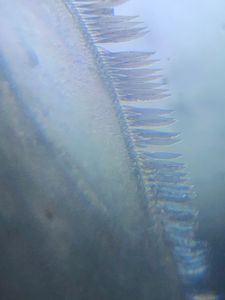Identifying Dengue mosquito under a foldscope
 Jan 08, 2020 • 7:16 PM UTC
Jan 08, 2020 • 7:16 PM UTC Unknown Location
Unknown Location 140x Magnification
140x Magnification Microorganisms
Microorganisms
Manu Prakash
I am a faculty at Stanford and run the Prakash Lab at Department of Bioengineering at Stanford University. Foldscope community is at the heart of our Frugal Science movement - and I can not tell you how proud I am of this community and grassroots movement. Find our work here: http://prakashlab.stanford.edu
266posts
1192comments
42locations

I first felt the wrath of Dengue when my cousin sister – living in Delhi – got the same and was best ridden for almost a month. It was a striking reminder of the wrath of this viral diseases – and although it does not take as many lives as malaria – the symptoms and what a patient has to go through is equally catastrophic.
All from a single bite of a mosquito.
Here we learn how to identify this deadly mosquito – Aedes agypti under a Foldscope.
Let’s first look at a microscopic sketch to identify some key features:
All from a single bite of a mosquito.
Here we learn how to identify this deadly mosquito – Aedes agypti under a Foldscope.
Let’s first look at a microscopic sketch to identify some key features:

(Original by Emil August Goeldi (1859 – 1917). • Public domain )
Figure1: Male on the far left, female on the far right. One simple way to identify male and female mosquitoes is from the size of the mustache (both have them, but male have a bushy mustache). This is called the Johnson Organ and is used to enable hearing (so it’s an ear for a mosquito).
Figure1: Male on the far left, female on the far right. One simple way to identify male and female mosquitoes is from the size of the mustache (both have them, but male have a bushy mustache). This is called the Johnson Organ and is used to enable hearing (so it’s an ear for a mosquito).


Figure 2: here is the foldscope view of the same – with male Johnson organ (bushy) and a female Johnson organ.
Next, you can notice the dramatic white bands on the legs and the body. If you focus on the legs – you should see clear zebra like patterns. They actually come from not pigments but lack of “hair” in that location which make it the appearance of white color. See below! This observation came quiet a surprise to me, although I see these mosquitoes all the time!
Next, you can notice the dramatic white bands on the legs and the body. If you focus on the legs – you should see clear zebra like patterns. They actually come from not pigments but lack of “hair” in that location which make it the appearance of white color. See below! This observation came quiet a surprise to me, although I see these mosquitoes all the time!



Next we look at the venation structure of the wings – which are unique for all mosquito species and hence can be used to identify mosquitoes. Look at which veins connect with other veins – and you have a “signature” of what species it is.
Here is a nice reference for the same:
https://journals.plos.org/plosone/article/file?id=10.1371/journal.pone.0161643&type=printable
https://www.sciencedirect.com/science/article/abs/pii/S1567134809002834?via%3Dihub
The key identification landmarks are shown here:
Here is a nice reference for the same:
https://journals.plos.org/plosone/article/file?id=10.1371/journal.pone.0161643&type=printable
https://www.sciencedirect.com/science/article/abs/pii/S1567134809002834?via%3Dihub
The key identification landmarks are shown here:

Fig: Fig 2. (A) Wing of Aedes aegypti (female) depicting the 18 landmarks chosen. (B) Geometric diagram linking all landmarks. Source: doi:10.1371/journal.pone.0137851.g002
If you now look back at the original wing image – 11.12 and 13 are clearly visible.
If you now look back at the original wing image – 11.12 and 13 are clearly visible.

Finally, here are some really nice images of some of the wing scales. We still don’t know what the role of wing scales is on the flight dynamics!


Sometimes, mosquitoes also fly into objects and the wings can get damaged. This is a was nice example of wing damage!

Next time, you have that mosquito buzzing around you; catch it and image it with a foldscope. You should be able to identify of it is one of the species capable of carrying a deadly disease. and of it is – it is time to clean out any water logged areas around your house and try to be vigilant (tell your neighbors – sleep under bed nets). We can prevent many vector borne diseases but science and advocacy have to be at the heart of the solution.
Keep exploring!
Cheers
Manu
Keep exploring!
Cheers
Manu
Sign in to commentNobody has commented yet... Share your thoughts with the author and start the discussion!

 0 Applause
0 Applause 0 Comments
0 Comments
















